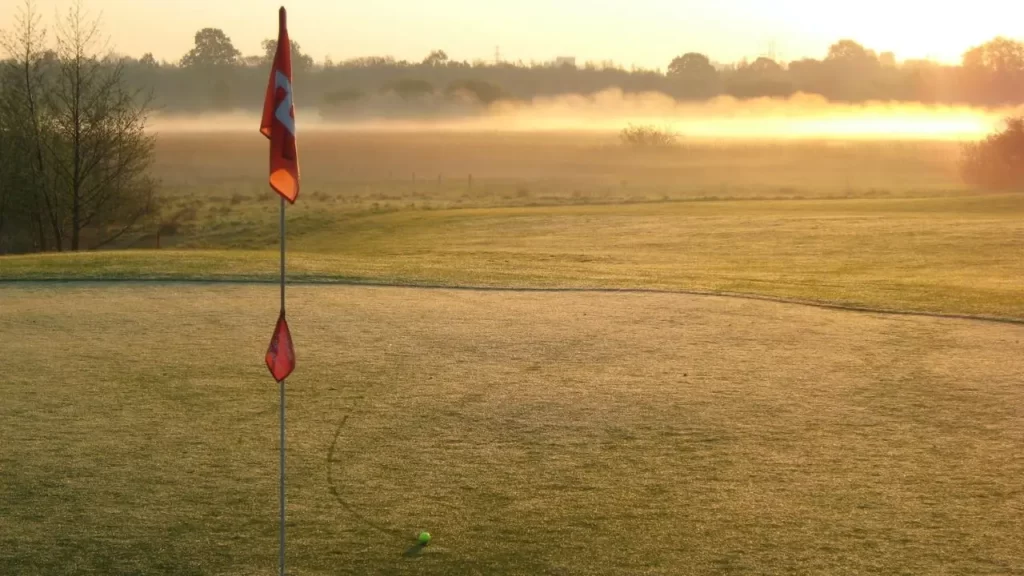Understanding What is Par in Golf: Tips and Insights
In golf, ‘par’ is the expected standard score for a hole. It sets the scoring benchmark, with proficient golfers aiming to match or go under par. Courses assign par ratings based on hole length and difficulty. Completing a hole in fewer strokes than its par is ‘under par’ and leads to scores like ‘birdies.’ Par guides strategy, improves scores, and even pros use it as a performance measure.

Key Takeaways
- In golf, “par” represents the standard score an expert golfer is expected to achieve on a hole. It’s a reference point for measuring performance on each hole and the overall course.
- Par values vary based on hole length and difficulty. Short par-3s, medium par-4s, and long par-5s each demand different strategies to achieve par or better.
- Golfers aim to match or go under par on every hole. Consistently playing under par or adjusting strategy to course conditions can elevate a player’s rank and overall performance.
- Par plays a crucial role in tournament play. Scoring at or below par for each hole is vital for success. Strategies consider course layout, weather, and individual skills.
- Misunderstandings about par abound. Par isn’t a fixed score for all golfers, and aiming for par on every hole might not yield optimal results. Par is a flexible benchmark to guide performance improvement.
Introduction
If you’ve ever played a round of golf, you’ve probably heard the term “par” mentioned once or twice. But what exactly is par in golf?
Simply put, par is the standard score that proficient golfers are expected to achieve on any given hole. But there’s much more to it than that!
To understand par in golf, we need to look at the history of the sport itself. The concept of par was first introduced in the 1800s as a way to standardize scoring across different courses.
Before then, there was no set score for each hole; players would simply tally up their number of strokes as they went along. Today, understanding golf course ratings and the pars of the holes is an important part of any player’s game.
Each hole on a course is assigned a specific par rating based on its length and difficulty level. A short hole might have a par rating of three, while a longer or more challenging one could be rated as a four or even five-part hole.
"Par represents the standard score for each hole. Proficient golfers aim to achieve or go under par. It's a pivotal concept for tracking performance and strategizing effectively on the course."
So what does it mean to be “under par” or “over par“? Essentially, if you manage to complete a hole using fewer strokes than its designated par rating, you’re said to be under par for that particular hole.
Enjoying this article? Read more:
Check out this video below from United States Golf Association (USGA)‘s Youtube channel:
For example, if you complete a three-par hole with just two shots, you’ve scored what’s known as a birdie – an impressive feat in any golfer’s book! Of course, not every golfer will be able to play at this level consistently.
The average golfer might shoot several strokes above the course’s set standards, resulting in scores over par for all holes combined. However, even professional players occasionally struggle with certain holes or courses and end up scoring higher than expected.
In the end, understanding what is meant by “par” gives us insight into how golf scores are calculated and how proficient players aim to perform on each individual hole. Whether you’re new to the game or a seasoned pro, keeping an eye on your golf score standard in relation to the course par can help you stay focused and motivated throughout your round.

What is Par in Golf?
Par is a term used in golf to describe the number of strokes it should take an average golfer to complete a hole or an entire round of golf. The USGA definition of par is “the score that a proficient golfer would be expected to make for a given hole“. Par is often used as the standard for scoring golf, and it is used to determine whether a golfer has played the hole under, over, or at par. Every golf course has differing lengths and challenges.
Therefore, each individual hole on the course will have its own par value based on its length and difficulty level. A short hole that requires only one or two well-placed golf shots may have a par value of three, while a longer hole that requires more shots will typically have a higher par value.
The sum of all individual holes’ pars creates the total par for an entire round of golf. For instance, if there are 18 holes and each one has a par value of 4, then the total par for that round would be 72 (4×18).
Skilled golfers aim to play each individual hole in as few shots as possible so they can shoot below par on each specific hole and on all holes combined. Par plays an important role in tournament play since it’s used to calculate scores for players competing against each other.
Golfers will try their best to score below par on every single shot, as it significantly affects their ranking against other competitors. It’s common for skilled players to keep track of their score versus PAR throughout their game so they know how many strokes above or below average they currently stand.
Enjoying this article? Read more:

The History of Par in Golf
Par is a familiar term for any golfer, referring to the number of strokes an expert player is expected to need to complete an individual hole. The origin of par and the established standard golf score are interesting elements of golf’s rich history. In 1911, the USGA introduced a formal definition for par in golf, asserting that it should reflect “the score that an expert player would be expected to make for a given hole.” At that time, it was rare for amateur players to record their scores since course rating was still in its infancy.
The advent of par as a benchmark standard instead allowed for better tracking and comparison among players. The sum of pars on every hole became the basis for establishing course ratings.
Before the introduction of course ratings, there was no uniformity or consistency in courses across different locations. The creation of ratings gave courses more credibility and allowed golfers from different areas to make fair comparisons.
"Par originated in golf as a benchmark for expert players. Its introduction in 1911 marked a shift towards standardized scoring and course ratings. The evolution of par enhanced credibility, allowing fair comparisons among courses and players."
Combined with developing technology and improved equipment, new courses have needed longer holes, which have been adjusted as per different pars. For instance, back in 1974 at Winged Foot Golf Club West Course during the U.S. Open, the 13th hole, which was shorter than usual, got converted into a five-par hole rather than its traditional four-par status.
Par means different things depending on who you ask; however, it has become an essential factor in competitive golf scoring metrics worldwide. For instance, one might hear the term ‘matched par,’ which refers to when two competitors achieve identical scores on individual holes or throughout an entire match.
Par is just one of many fundamental concepts that define golfing standards today. Understanding its origin adds further depth and appreciation towards how key scoring metrics were developed over time, leading to their current definition today by the USGA as well as other governing bodies worldwide such as the R&A, etc., making birdie shots much more rewarding!

Understanding Golf Course Ratings
Golf course ratings are an essential component of understanding the difficulty level of a golf course, measuring the number of strokes an expert golfer is likely to complete a hole.
The United States Golf Association (USGA) defined golf ratings as “the evaluation of the playing difficulty of a course for scratch golfers under normal course and weather conditions“. In simpler terms, it means how hard a particular golf course is to play for experienced players. The rating system takes into account various factors such as distance, hazards, elevation changes, and roughs.
It also considers how well-maintained the holes are and the number of strokes required to complete each hole. These ratings are used by tournament organizers worldwide to ensure fair play among players.
Golf course par is predetermined for each hole based on its rating. Generally speaking, par-4 holes will have a par rating ranging from 3 to 5 strokes.
"Golf course ratings gauge course difficulty for skilled players. A blend of factors including hazards, length, terrain, and par shapes these ratings. They aid tournament fairness, guide strategy, and enable accurate player handicapping for balanced competition."
Meanwhile, par-5 holes may require six or seven strokes to complete due to their length or difficulty level. The USGA definition of par is “the score that an expert golfer would expect on a hole in which she or he hits two good shots and putts without errors.”
Enjoying this article? Read more:
Check out this video below from Ninh Ly‘s Youtube channel:
Course difficulty is another factor that is taken into account when determining golf ratings. It includes how easy or difficult it is for players to hit accurate golf shots on specific holes due to terrain changes such as blind shots or doglegs.
Understanding golf course ratings plays a significant role in determining whether a player can meet the expected score (par) and ultimately affects their scoring during tournaments. Determining these scores allows for more accurate handicapping that can help level out any differences in skill levels between players, leading to fairer competition.
Enjoying this article? Read more:

Types of Holes and Their Par Values
Now that we understand what par means in golf, let’s delve into the different types of holes and their associated par values. First, we have the par-3 holes, which are typically shorter in distance and require only one stroke to reach the green. These holes are usually around 100-250 yards long and can be challenging due to their small greens and tricky bunkers.
Many golfers relish the opportunity to score a birdie on a par-3 hole, as it can be quite an achievement. Next up are the par-4 holes, which offer a bit more of a challenge than their shorter counterparts.
Par-4s range from about 250-500 yards long and usually require two strokes to reach the green. These holes often feature hazards such as water or sand traps that come into play on both the tee shot and approach shot.
Scoring par on a difficult par-4 can feel just as rewarding as scoring a birdie on a short par-3. We have the longest of them all – the par-5 holes.
"Golf boasts varied hole types with distinct par values. Par-3s demand precision, while par-4s introduce challenges with 2-stroke goals. Lengthy par-5s need 3 strokes and strategy. Coursewide cumulative par influences tournament performance, emphasizing the importance of understanding each hole's par value for effective gameplay."
These beasts can range from 500 to over 700 yards in length and typically require three strokes to reach the green. Some expert golfers may attempt to reach these greens in two shots with well-placed drives and fairway woods, but for most players, it’s all about managing their shots intelligently to avoid hazards and set up manageable approach shots.
Scoring under-par (a birdie or eagle) on these types of holes is considered quite an accomplishment. It’s worth noting that while each individual hole has its own predetermined par value based on its length and difficulty, there is also an overall course par that takes into account all 18 holes‘ scores combined.
This cumulative course difficulty plays a significant role in tournament play since players will strive not only for individual hole pars but also for an overall score under this cumulative course-defined number. Understanding each hole’s par value and how it fits into the overall course par is essential for scoring golf.
It’s also vital for selecting the right club and playing strategy for each hole, depending on one’s own skill level and experience. Whether you’re a proficient or amateur golfer, knowing what par means in golf can help guide your play and improve your overall performance on the golf course.

The Role of Par in Scoring
When it comes to golf, par is usually the target score for each hole. So, what exactly is the role of par in scoring? Well, it’s really simple: par provides golfers with a standard score to aim for on each hole.
By aiming to achieve par or better on every hole, golfers can calculate their overall score and determine how well they’ve performed. Golf scoring can be a bit confusing at first, but understanding the role of par is a great place to start.
The term “par” comes from golf terminology and refers to the predetermined number of strokes an expert golfer would be expected to take on a particular hole or over an entire course. For example, if a golfer completes a hole in 3 strokes when the standard course calls for 4 strokes (or more), they have achieved par.
The sum of pars for all holes on a course represents its standard score; this is used as the basis for calculating individual and tournament scores. To keep track of your score throughout your round of golf, you simply add up the number of golf strokes it takes you to complete each hole and compare that total against the sum of pars for those holes.
Par plays an essential role in determining how proficient you are at playing golf. For instance, if you consistently play under-par rounds (meaning you complete all or some holes below their predetermined value), then it shows that you’re an expert golfer who knows how best to approach different types of holes.
Par acts as a scoring standard in every round of golf by providing players with predetermined values that represent what they should expect from each individual shot during playtime. With par as a guidepost, players can aim towards goals set out by courses or tournaments while keeping track of their scores at every turn!
Enjoying this article? Read more:

Strategies for Playing to Par
When it comes to playing golf, everyone wants to be able to shoot par or better on a consistent basis. However, that is easier said than done. It takes a lot of practice and patience to become a proficient golfer, but there are some strategies you can use to help you play to par.
One strategy for playing to par is to focus on your short game. Short-game shots such as chipping and putting account for roughly 60-65% of all shots taken during a round of golf. If you can improve your short game and get up and down from around the green more often, you will have a better chance of making par or better on each hole.
Another strategy is to approach each hole with a plan in mind. Look at the ratings and pars of the holes on the scorecard and decide where you need to hit your tee shot in order to give yourself the best chance at making par. For example, on a long par 4, you may want to hit a shorter club off the tee in order to leave yourself with a more manageable approach shot.
Differing lengths between holes can also present challenges when trying to play consistently around par. When faced with long holes or five-par holes that are out of reach in two strokes, it may be wise not to chase after birdies or eagles but rather to content yourself with getting pars or bogeys instead.
Another strategy is understanding how par distribution could affect your scoring if played correctly depending on handicap level, where low-handicappers have different strategies compared with high-handicappers aiming for under-par. It’s important not just to chase after birdies every hole but to play smartly within one’s level of expertise while keeping an eye towards improving one’s score over time using the sound strategies described above while having fun playing what is considered by many to be one of the greatest games ever invented: – Golf!
Check out this video below from wilmaneese‘s Youtube channel:
Enjoying this article? Read more:

The Impact of Par on Tournament Play
Being able to consistently hit par is crucial for any professional golfer hoping to make it big in the sport.
In golf tournament play, par has a significant impact on the overall outcome of the game. In fact, one or two strokes can make all the difference between winning or losing a tournament.
In professional tournaments, golfers are expected to play each hole at or below its predetermined par rating. A bogey or higher score on any hole can quickly drop a golfer in rankings and make it difficult to recover.
On the other hand, consistently scoring birdies on holes can help propel a golfer ahead of their competitors. During tournament play, specific strategies are employed to help players achieve and maintain par scores throughout each round.
Golfers pay close attention to various factors such as wind speed and direction, course conditions, and their own personal golf technique when determining how many strokes are required for each individual hole. The course itself also plays a significant role in determining players’ scores throughout the tournament.
"Consistently hitting par is vital for pro golfers aiming for success. In tournaments, par can be the thin line between victory and defeat. Professionals strategize for par or better, as bogeys can drop rankings. Birdies boost standings. Weather, technique, and course shape affect par decisions. Professionals adjust to hole difficulty, manage shots, and uphold cumulative course par for competitive edge."
Each hole is assigned a specific par rating based on its length and difficulty level. Golfers must adjust their approach depending on whether they are playing an easy or difficult hole in order to maintain their overall score standard.
Maintaining course par is especially crucial when playing medium-sized holes with differing lengths and hazards placed strategically along the course. Professional golfers must keep track of their shots carefully throughout each round in order to ensure they stay within the expected stroke count.
Overall, understanding how par affects tournament play is critical for all aspiring professional golfers looking to achieve success in this competitive sport. By mastering techniques that help them consistently hit pars of the holes while still being open-minded enough to adjust when needed based on individual circumstances like weather conditions, players may be able to accomplish great things on both local courses as well as larger stages such as national tournaments and even international competitions with some hard work at dedicated golf facilities!

Common Misconceptions About Par
One of the most common misconceptions about par in golf is that it represents the score that an expert golfer should achieve on each individual hole. This is simply not true.
While it’s true that par represents the standard score for a hole, it’s important to remember that this standard score is based on a number of factors, including the length and difficulty of the hole. So while an expert golfer might aim to shoot under par on each hole, achieving par or even slightly over par might still be considered a good score for most players.
Another common misconception is that cumulative par represents the total number of strokes a golfer should aim to take on an entire course. In reality, cumulative par simply refers to the sum of all the individual pars for each hole on a course.
So if a golf course has 18 holes with a standard par of 72 (4 per hole), then its cumulative par would be 72 x 18 = 1296 strokes. Many golfers also believe that they should aim to play every four-par (or any other specific type of) hole at exactly even par (i.e., two strokes per shot).
However, this isn’t necessarily true either. While playing four-par holes at under-par can certainly help improve your overall score, trying to play every single four-par hole at exactly even par can actually hurt your game by putting unnecessary pressure on you and causing you to lose focus on other aspects of your game.
Some people believe that golf ratings are determined solely by how well individual players perform relative to par on each hole. However, while scoring relative to par is certainly an important factor in determining golf ratings, there are many other factors involved as well, including course difficulty and slope rating.
Understanding what “par” really means in golf can help you become a better player and enjoy the game more fully. By recognizing these common misconceptions and focusing on the true role of par in golf, you’ll be well on your way to improving your game and achieving the scores you desire.

Conclusion
Understanding par is crucial for anyone who wants to play golf. Par is not just a scoring term
FAQs
What does par mean in golf?
Par in golf refers to the number of strokes an expert golfer is expected to take to complete a hole. It sets the standard score for each hole, guiding players’ performance.
What does par 72 mean in golf?
Par 72 indicates the total standard score an expert golfer is expected to achieve for an 18-hole golf course. It’s the sum of the pars for all the individual holes.
What does 3 par mean?
A 3-par hole requires an expert golfer to complete the hole in three strokes. It’s a shorter hole, often characterized by its distance and difficulty level.
How is par calculated in golf?
Par is calculated based on the distance and difficulty of a hole. It reflects the number of strokes an expert golfer would take to reach the green and putt the ball.
How many points is a par?
A par earns you zero points in golf. Scoring below par earns negative points, while scoring above par earns positive points.
How many hits is a par?
A par typically requires completing a hole in the same number of hits as the par value of that hole. For instance, a par-4 hole should ideally be completed in four hits.
How many swings is a par?
A par in golf is ideally completed in the same number of swings as the par value of that hole. Each swing counts toward completing the hole.
Why is there no par-6 in golf?
Golf standards have set par values based on the difficulty and length of a hole. Since a par-6 would imply a hole longer than is conventionally designed, it’s not included in standard courses.
How many strokes is even par?
Even par means completing a round with a total score equal to the sum of the par values of all holes. This score is typically a reference point for evaluating a golfer’s performance.
What is a 2 on a par 5 called?
A 2 on a par 5 is called an “eagle.” It means completing the hole in two strokes fewer than its designated par value. It’s an impressive achievement in golf.
Share this Post
Toni Benedito
Keep Reading
Follow Us
Recent Posts

The Shocking Cost: How Much Does It Cost to Fly with Golf Clubs?
Flying with golf clubs can be a hassle, but it’s worth it for avid golfers. Costs vary by airline, ranging from $30 to $150 per way. Southwest Airlines offers a generous policy, allowing one set

Why Do Golfers Tape Their Fingers Before Hitting the Course?
Golfers tape their fingers to prevent injuries from repetitive motions, provide support for existing injuries, and improve grip comfort. It’s a popular technique among amateurs and pros alike, offering a lightweight and effective solution compared

How Much Does a Round of Golf Cost? Are You on Par?
The cost of a round of golf varies widely based on factors like course type, location, and time of play. Public courses typically range from $30-$100 per round, while exclusive ones like Augusta National or

Hidden Fees: How Much Does It Cost To Rent a Golf Cart
Wondering how much it costs to rent a golf cart? Explore factors like location, rental duration, and cart type impacting prices. Daily rates range from $50 to $80, while weekly rentals can vary from $200

How Much Does a Golf Bag Weigh? The Ultimate Guide
Golf bag weight varies depending on type and materials, ranging from 2 to 70 pounds. Factors include stand bags for carrying, cart bags for carts, and tour bags for professionals. Consider bag weight for game

Hitting Driver Too High? How to Fix It for Lower Flight!
Discover why hitting the driver too high affects your golf game. Learn how swing mechanics, setup adjustments, and proper equipment can help you hit longer and more accurate drives. Key Takeaways Improving swing mechanics through
Table of Contents








